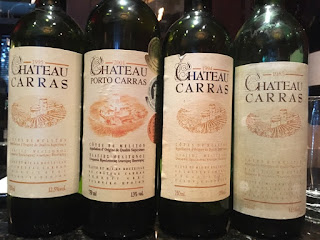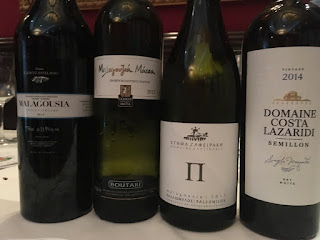 |
| Breakfast at Locando Cos on the COS estate |
According to Paolo, the estate has been in his family since 1780. There were vineyards here when he was a kid and coming here to play. Those vineyards had apparently been abandoned because, according to the estate's website, there was a replanting in 1990. The estate was turned over to Paolo by his father in 2008.
Cantine Paolo Cali is located in the Salmé district of Vittorio in the heart of the Cerasuolo di Vittoria DOCG and Vittoria DOC regions. Within the larger estate, 15 ha of organic vineyards are planted on pre-historic marine dunes at elevations of 180 m. Two of plots -- Forfice and Frappato -- are planted on these beach sands.
As we drove between the rows, Paolo pointed out the sandy portions, which stood in sharp contrast to the redder soils in other portions of the same vineyard. The sand is approximately 8 m thick and is undergirded by a limestone bedrock. These dunes were under the sea at sometime in the distant past, a sea which is currently 10 km away from these vineyards.
The vineyards are planted to the indigenous red varieties Frappato and Nero d'Avola. The Nero d'Avolo vines are between 10 and 15 years old, planted on 114RUG rootstocks, and are cordon-trained. Planting density is 5000 vines/ha. The white wines are made from Grillo grapes grown in Bulera at 350 m on limestone-rich clay with many rocky outcroppings.
As he reached down and threaded the soil through his fingers, Paolo began a discourse on its impact on the wines. "Because of the soil, there are no muscular wines here. The wines, instead, are fine, elegant, and possess some salinity."
All vineyard operations are manual in nature to include hoeing, planting, dry and green pruning, and green harvesting. The estate utilizes canopy management in order to extend the growing season for up to three weeks.
No chemicals or fertilizers are used in the vineyard but the vines are subjected to copper sulfate spraying four to five times per year. In terms of pests, the vineyard hosts crickets that burrow down and eat the root structure. There is no defense other than to turn the soil over, moving the crickets temporarily away from the vulnerable deeper roots.
The arid conditions dictate (deficit) irrigation two to three times per year.
Grapes are harvested by hand with the pick-decision based on taste. There is rigorous selection during harvesting. Fermentation is conducted in temperature-controlled stainless steel tanks with natural yeasts.
 |
| Paoli Cali explaining the vines and training system |
 |
| Vineyard pruning in background; Paoli and Vineyard Labor Supervisor in foreground |
 |
| Vineyard and soils. Note Albarello end-cap |
Our tasting started out with a 2015 Grillo. Paolo said that that had not been a great vintage in the region. The wine exhibited pineapple, grapefruit, and a florality on the nose. On the palate, sapid and mineral with great texture and weight. A ferrous character. This wine was fermented with selected yeasts. Paolo was very happy with this particular Grillo.
They select the grapes specifically for this wine. In 2015 they harvested pre-ripeness and got a fresh Rosé with light color and more acidity. After harvest, the grapes are cooled down to 8℃. When he likes the color, after four to five days, he de-stems and removes the seeds. The juice is then warmed to 60 degrees and fermented with selected yeasts. 4g/L of sugar is added and the wine chilled to 0℃ in order to arrest fermentation, resulting in CO₂ petillance. It is held at 0℃ until bottling and is clarified naturally.
This wine was salmon-colored. Strawberry and cherry on nose. Unctuous with a richness. Bright acidity and spiciness. Rust character.
The next wine tasted was the 2014 Mandragola, a 100% Frappato wine. This wine was aromatic with red fruit, dried herbs, chalk and carob on the nose. Good weight and full on the mouth. Red cherries. Good acidity. Bitter finish. From 2015 on this wine will be vinified in barriques.
Paolo sees Nero d'Avola as an important wine for Eastern Sicily and his estate's contribution in this area is a 100% variety named Violino. On the nose savory, kerosene, phenolic, with plum and carob notes. The kerosene character carries through to the palate. Broad-based fruit with good acidity and late-arriving tannins
Jazz is a Frappato (55%)-Nero d'Avola (45%) blend. We tasted the 2015 vintage of this wine. Paolo chose this blend as a friendlier, easier-drinking wine. It is cleaner because of the high levels of Frappato. Fruit very evident but with high levels of acidity.
Manene is classed as a Cerasuolo di Vittorio Classico and was the winery's first entry in the class. The wine is named after his son. The blend in this wine is 60% Nero d'Avola and 40% Frappato. The 2012 version that we tasted exhibited nuttiness on nose and a savoriness, dried herbs, earth, dust, red cherries, bright acidity, and liveliness on the palate.
Forfice is also a Classico DOCG but is made from grapes sourced from a specific plot of the same name. The Frappato and Nero d'Avola are macerated together for 100 days before being co-vinified. The wine is aged for 36 months in 30 hL oak barrels and then spend another 6 months in bottle. Nuttiness, savoriness, dried herbs and sawdust on the nose along with cherries and strawberries.
 |
| Lineup of wines tasted |
As a capper to the morning Paolo brought out a bottle of 1932 Cerasuolo. As he explained it, this was a family wine that has been stored in a 250 L chestnut vat and is only tapped for special events like holidays, festivals, and family occasions. He was somewhat sheepish in offering it, apologizing ahead of time for any injury that it might cause. He had nothing to apologize about.
The wine was golden in color, providing a visual clue to the presence of oxidative notes (or oxidation). On the nose, an elegant tawny port, figs, dates, walnuts, coffee, dried cocoa, and burnt orange. On the palate smooth, balanced with a surprising amount of acid still present after all these years. Oxidative notes that struck the right tones. Surprisingly different than what I was expecting. Still a lot of life left in this baby. Long, smooth tropical finish. I luxuriated in this wine and rued the fact that we had to leave abruptly -- with most of the bottle still intact -- in order to get to another appointment.
This was an excellent visit. Paolo was the perfect host throughout and his estate is producing wines of very high quality. One other intangible: he has a story to tell about his estate and he does so with enthusiasm and great emotion.
©Wine -- Mise en abyme


















































